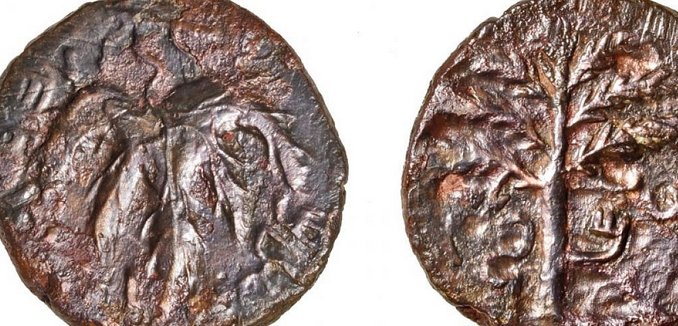A recently discovered coin stamped with the phrase “for the freedom of Jerusalem,” which was found in a cave outside of the central Israeli city of Modi’in, suggests that the Bar Kochba rebellion against Roman rule following the destruction of the second Jewish Temple had more widespread support than previously thought, The Times of Israel reported.
The finding was revealed Thursday, which is Lag B’Omer on the Hebrew calendar, a day when the ultimately unsuccessful revolt is commemorated. That the bronze coin was found so far from Jerusalem, where the revolt was centered, “is important evidence for historians in corroborating the broad geographical spread of the revolt and its supporters,” the Times reported.
Previously, historians and archaeologists thought that the revolt didn’t have much support north of Jerusalem, but the coin and other recently discovered activity in the region suggests that rebels were also active in the area.
One side of the coin depicts a seven-branched date tree with two bunches of dates with the Hebrew letters “שמע,” apparently referring to Shimon Bar Kochba, leader of the rebellion. The other side showed a grape leaf and an abbreviated phrase which means “for the freedom of Jerusalem.”
The coin was discovered in the course of digs supervised by the Defense Ministry’s Coordinator of Government Activities (COGAT) in the Territories, Bar-Ilan University, and Ariel University. The excavations, which began in 2014, were launched to study the southern part of Samaria.
“We assume there are many archaeological artifacts that have not yet been discovered in the Judea and Samaria region,” explained Hananiya Hizmi, head of the COGAT archaeology unit. “We are working in cooperation with many bodies, with the goal of uncovering and discovering historical pieces from the Jewish people in the area.”
Shards of glass and pottery dating to the time of the rebellion were also found in the cave.
The revolt, which lasted for three and a half years was the final Jewish revolt against foreign domination during ancient times. It was effective enough that Dio Cassius, a third-century historian, wrote that the Romans had to deploy Roman Legion soldiers from other locations to end the rebellion.
Coins from the Bar Kochba revolt are unique in that they are stamped over other coins. There is a debate whether the overstamping was due to necessity or a way of registering opposition to Rome. Coins from the first two years of the revolt had the date inscribed on them. Afterward, no dates were inscribed on the coins. However, they can be identified by the inscription “for the freedom of Jerusalem.”
[Photo: COGAT Spokesperson ]




